Week 10¶
I was planning on doing weekly updates but everything went sideways on Electronics Production week and while I’ve mostly managed to keep up with weekly assignments writting documentation has been an impossible challenge.
As I kept on doing research for my final project I wanted to do at least 3 major updates on stuff I found which I’ll try to fit together into a longer, albeit as succinct as possible, update.
CMM¶
As a minor update I’ve found out the technical term for my final project is Coordinate Measure Machine (CMM); so no more calling it a templater.
Sensors¶
For this project I’ll need to figure out angles across the XY plane, heigth on the Z axis so I know the direction of the probe and how far the probe is. The easiest way to read the distance will be to get the probe cable to wind around a known radius cylinder and read how much that turns.
That means I’ll need 3 angle sensors or close to it with the highest precision I could find.
My fellow fablab students at FCT suggested either specialized angle sensors or maybe rotational encoders.
- Rotational encoders in theory can read angles but they are usually very limited on the minimum angles they can sense with common encoders where between 10 and 24 steps/rotation. Highest precision encoder I found on sale in Portugal was a YUMO E6B2-CWZ3E with 1024 steps or 0.35° precision which is respectable but costs 53€ with VAT each so #Pass.
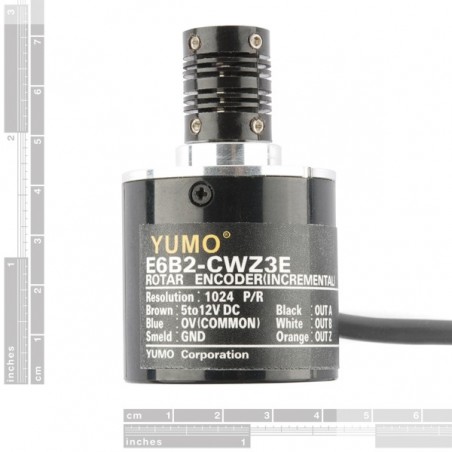
- Angle sensors is where it gets interesting… The store that had the Yomo also sold precision angle sensors that were a couple orders of magnitude better. These claimed to be sensitive down to 0.088° but cost 70€ a piece so uh.. #HellNo.
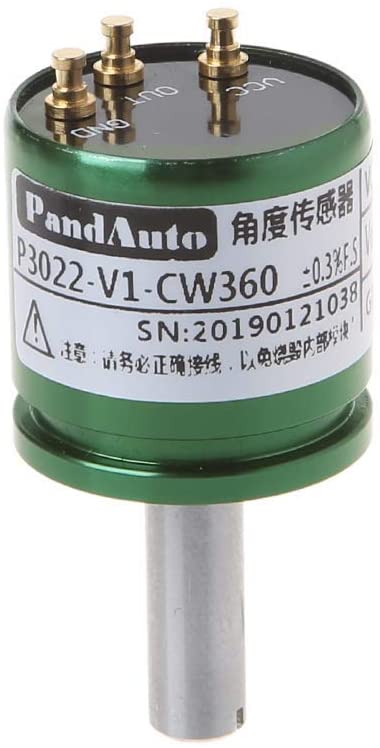
But they looked so nice I tried finding them for sale in other places. Got down to around 25€ each without VAT but the stores all seemed kinda shady so I had mostly gave up. Did manage to find 2 brands which seem to be OEMs for these kinds of packaged sensors, PANDAUTO and CALT.
While I was fantasizing about the precision on these angle sensors I noticed they mentioned they were Hall sensors so might as well dig a bit deeper. I started getting more comfortable with the Digikey search engine and started to find sensors that looked similar to what I was looking for like the Amphenol Piher Sensing Systems PSC360G2 or the TT Electronics 6150 but these were still over 50-60€ a pop without VAT.

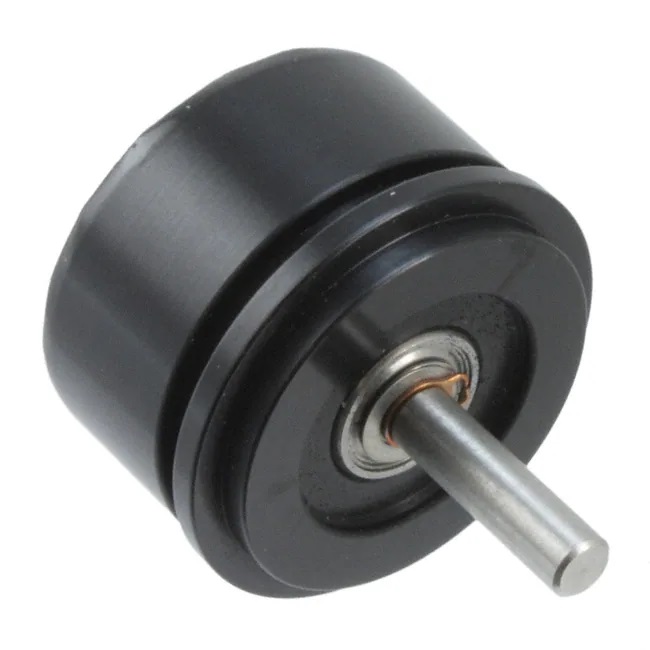
Datasheets seemed consistent with sample resolution even if output signals were a mix of analog and a couple digital options but mostly PWM.

It was probably time for me to know what a Hall Effect sensor was to begin with as all these 360° seemed to use it.
It was easy to find some clips on youtube that helped me understand out how they work. I got very lucky with the algorythm sugestion on the 1st page of results because this clip is from a company that actually made Hall Effect Sensor chips.
By the end of the clip I mostly understood the basics of hall effects sensors but most importantly I remembered they showed the name of an actual model for 20ish seconds at the start of the clip…
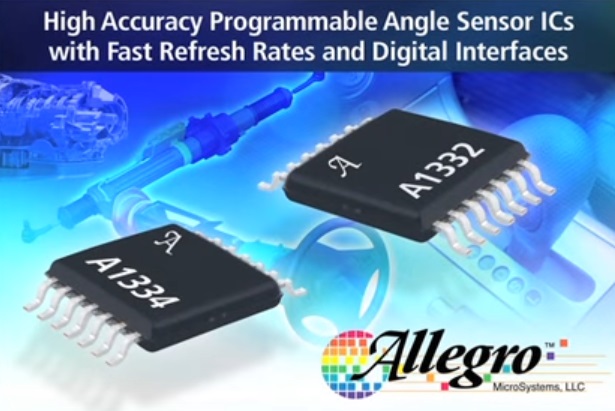
So with the brand and model I could research the actual sensor chips… watched a few more videos until it clicked… Why am I looking at fully packaged sensors with an integrated shaft/magnet when I could just get sensor chips and build the whole thing myself? I mean that’s kind of the point of FabAcademy, right? Right?..
Got back on DigiKey’s search engine to see what I could find and while the A1332 was discontinued Allegro came out with an updated sensor in 2021. #Noice
Hopefully the A31315 is even more consistent than the A1332 but both options were now in the realm of 5-6€ without VAT. That’s an order of magnitude cheaper than the assembled sensor package… As my understanding of DigiKey’s search grew I managed to find a few more brands and models of Hall Effect Sensors that seemed good enough for what I was looking for.
For example the AMS AS5048B-HTSP. Bit more expensive at 7-9€ each but it might be a bit more precise than the others? I’m not fluent in datasheet yet so I’ll need more practice.

The AS5048B can even use I2C and nice enough this week was Output Devices so while I haven’t been able to do much work on it as my instructor is isolating after testing positive for SARS-CoV-2 and inventory being so very low I did research on a bunch of stuff including I2C so now when I read these datasheets and it comes up I know what is so that’s nice.
Another nice thing about the AMS AS5048B-HTSP’s datasheet was that it mentioned how to pick a magnet which I didn’t noticed when I skimmed through other sensors’.

They might mention it but it’s not too important yet anyway.
I’ll have to talk to my instructor and see which one we can get. Maybe even a couple different models in time for Input Device week so I could test each one to see if they’re beeing too optimistic on the oficial stats.
Probe Wire Tension¶
I always knew I needed a specific wire; that had 0 elasticity, wouldn’t memorize the shape of being all tightly wound for long periods of time, etc. But one thing I kept thinking about was how to give it enough tension to pull on it so it was all stretched enough to have consistent readings but not too strong as to make the probe unusable or even make the probe lift the base of the machine and screw up all readings.
Regular springs were out of the question as I was aiming for a few meters of wire radius to get a nice volume allowance for people to take advantage of. At least a small room of possibilities.
Then I remembered Roller Shutter Strap Coilers as I’ve taken a few appart. Couldn’t find a picture of a disassembled one but I’m talking about these:
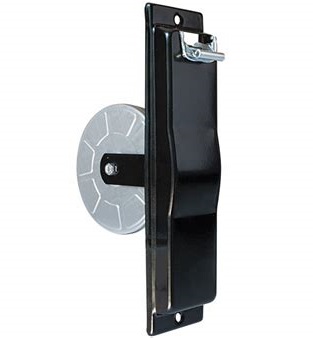
But they’re made to roll only a few meters of strap and are strong enough to probably pull on the base and lift it.
Brought it up with my local instructor and he just said measuring tapes… Which seemed like the logical next step but I still didn’t think of it.
Got a snap of a measuring tape coil from this clip on reparing one.
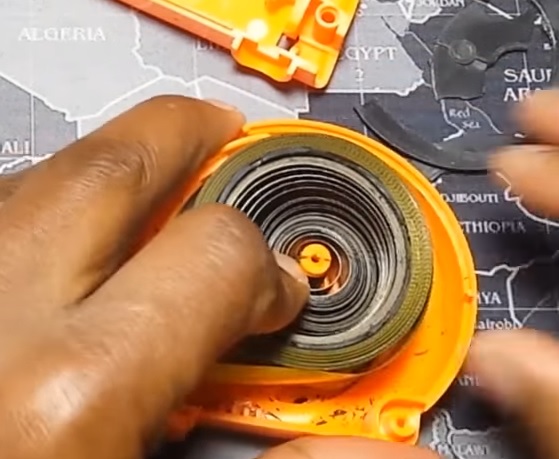
In theory measuring tape coils seem perfect. They extend for a few meters and might pull just enough to stretch the cable probe to sensor.
MVP and Limiting Project Scope¶
Now that I’ve figured out the sensor part and the basic structure of how things might go together I need to start a list of items/features that make up the most basic version of this kind of Coordinate Measuring Machine and a few extra nice to haves in case I can get to them, possibly show off some more stuff I’ve learnt along the way. Like having a cast resin handle on the probe as was kind of my plan in the Molding and Casting assignment.
Minimum Viable Product:
- Ability to read the 3 angle sensors so I can get a position in the XY plane, an angle for the Z axis and probe distance.
- A button to register/comunicate a measured datum.
- A buzzer for an audio cue of a complete registry/comuncation function.
- Either a local registry to an sd card or serial output of said datum.
Optional features:
- Computing the raw data into spacial coordinates inside the integrated controller would be cool. Been a while since I mathed so I’d have to spend some time on that.
- The button can be on the machine but having it on a longer cable or even a wireless controller would be great for usability.
- An SD card reader or 2 would be cool. Biggest consideration is having enough pins available to begin with.
- A monitor on the machine would be nice too. At least to show a list of the last datums generated and at best have it own interface for functions like reconstructing the datums in visual 3d space.
- Some extra gadgets for the probe.
- Make some preparations for further CMM development like a Total Station uses a Laser for measuring distance or Articulated Arm CMMs as I’m guessing the math for spacial relationships would be mostly the same.
Week 10ish Conclusions¶
Next step is talking to my instructor so we can figure out together what we can source. Reading many a datasheets to make sure everything is compatible and maybe start getting a circuit schematic together. Maybe also start thinking about shapes and how everything will go together now that I’m mostly sure about what kind of sensors I’ll use.
The sensors seem sensitive enough that I can connect them directly and not have to deal with backlash from doing a few gear reductions. Also need to remember I need to stick a magnet on one end of each axis.